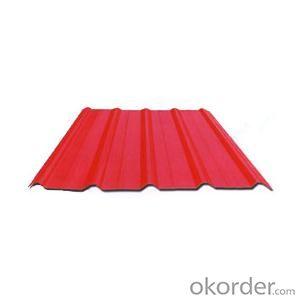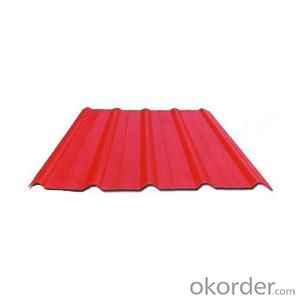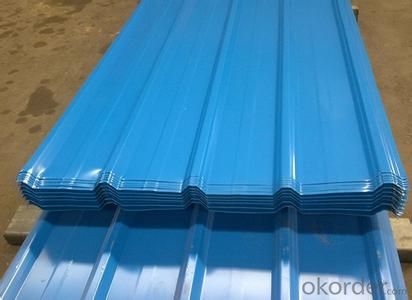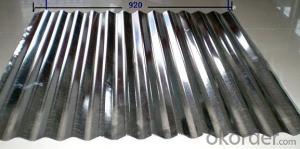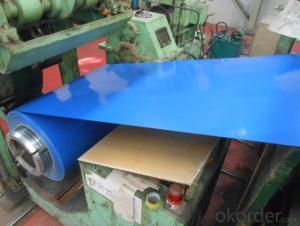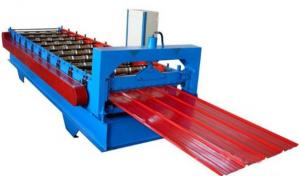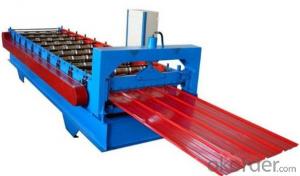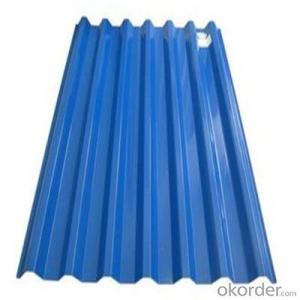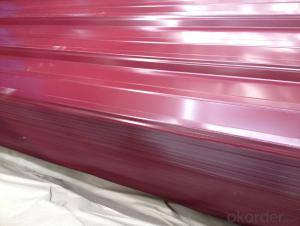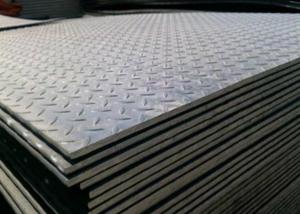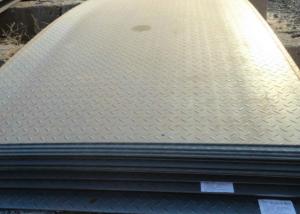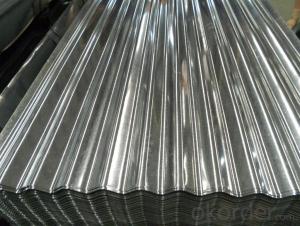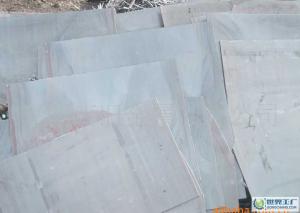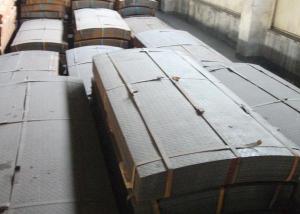PRE-PAINTED GALVANIZED STEEL CORRUGATED SHEETS
- Loading Port:
- Tianjin
- Payment Terms:
- TT OR LC
- Min Order Qty:
- -
- Supply Capability:
- 10000 m.t./month
OKorder Service Pledge
Quality Product, Order Online Tracking, Timely Delivery
OKorder Financial Service
Credit Rating, Credit Services, Credit Purchasing
You Might Also Like
PRE-PAINTED GALVANIZED STEEL CORRUGATED SHEETS
THICKNESS:0.25mm/0.27mm/0.30mm
WIDTH:820mm (0/+5mm, AFTER CORRUGATION)
LENGTH:3000mm (0/+5mm), 5800mm (0/+5mm)
ZINC COATING:80g/m2
STANDARD:JIS G 3312, CGCC (SOFT QUALITY)
TOP COATING:5+15 MICRON(POLYESTER); BACK COATING:5-7 MICRON (EPOXY),LIGHT GREY
COLOR:RAL3013 (RED TOMATO)
PACKAGE WEIGHT:3-5 tons
SPE:
| 0.25*820mm*3000mm (167-171 pcs) | ||
| 0.27*820mm*5800mm (79-83 pcs) | ||
| 0.30*820mm*5800mm (71-75 pcs) |
PROFILE IS ATTACHED TO BE CONFIRMED

- Q: Can steel sheets be used for manufacturing shipping pallets?
- Certainly, the utilization of steel sheets is applicable in the production of shipping pallets. Steel, a material known for its strength and durability, is capable of enduring heavy loads, rendering it suitable for pallet construction. To establish a robust and dependable pallet structure, steel sheets can be united through welding or bolting. Furthermore, steel pallets possess the added advantage of being resistant to moisture, pests, and fire, which holds significance in certain industries or applications. Nevertheless, it is important to acknowledge that steel pallets generally incur higher costs compared to alternative materials like wood or plastic. Therefore, the decision to employ steel sheets for manufacturing shipping pallets would rely on specific requirements, budgetary constraints, and intended utilization.
- Q: Can steel sheets be used for medical equipment?
- Yes, steel sheets can be used for medical equipment. Steel is a durable and hygienic material that is often used in the manufacturing of medical instruments, surgical tools, and equipment due to its strength, corrosion resistance, and ease of sterilization.
- Q: What are steel sheets?
- Steel sheets are flat, thin pieces of steel that are made by rolling or pressing steel into different shapes and sizes. They are commonly used in construction, manufacturing, and other industries for various applications such as building structures, automotive parts, and appliances.
- Q: Do the steel sheets have any specific certifications?
- Yes, the steel sheets have specific certifications.
- Q: What are the different sheet metal forming techniques for steel sheets?
- There are several sheet metal forming techniques for steel sheets, including bending, deep drawing, punching, shearing, and roll forming.
- Q: What is the maximum width of steel sheets available?
- The maximum width of steel sheets available may vary depending on the supplier and the specific type of steel. However, it is common to find steel sheets with a maximum width of around 72 inches or 6 feet.
- Q: Can steel sheets be used for noise barriers?
- Yes, steel sheets can be used for noise barriers. Steel is a durable and robust material that can effectively block or reduce the transmission of sound. It has high density and mass, which helps to absorb and reflect the sound waves, preventing them from passing through the barrier. Steel sheets can be specifically designed and manufactured for noise reduction purposes, with features such as perforations or acoustic insulation materials to enhance their effectiveness. Additionally, steel sheets can be coated or painted to improve their resistance to weather conditions and corrosion. Overall, steel sheets are a viable option for constructing noise barriers, especially in areas with high levels of noise pollution.
- Q: What are the different types of steel sheet coatings?
- In the market, there exists a variety of steel sheet coatings, each possessing its own unique properties and advantages. Some of the most commonly utilized types are as follows: 1. Galvanized Coating: This coating is extensively employed for steel sheets due to its exceptional corrosion resistance and ability to prevent rust. It involves the application of a zinc layer onto the steel surface. Galvanized coatings find widespread use in outdoor applications such as roofing, fencing, and automotive parts. 2. Galvannealed Coating: Similar to galvanized coating, galvannealed coating also entails the application of a zinc layer onto the steel surface. However, in this process, the coated steel undergoes a high-temperature annealing process, resulting in the formation of an iron-zinc alloy coating. This type of coating offers improved paintability and weldability, making it ideal for applications that require subsequent painting or welding. 3. Aluminized Coating: Aluminized coatings involve the application of an aluminum layer onto the steel surface. This offers exceptional heat resistance and corrosion resistance, making it suitable for applications involving high temperatures, such as exhaust systems and ovens. Aluminized coatings also possess good reflectivity properties, which make them valuable for reflective insulation applications. 4. Organic Coatings: Several organic coatings, including epoxy, polyester, and polyurethane coatings, are available for steel sheets. These coatings are typically applied as paints or powder coatings and provide a protective layer that enhances the durability and appearance of the steel. Organic coatings can be tailored to offer specific properties, such as UV resistance, chemical resistance, or decorative finishes. 5. Tin Coating: Tin coatings are commonly utilized in the food packaging industry. They create a barrier between the steel sheet and the food product, preventing any interactions that could compromise the quality or safety of the food. 6. Other Specialty Coatings: Several other specialty coatings are available for specific applications. These include zinc-nickel coatings, which offer enhanced corrosion resistance, and ceramic coatings, which provide high-temperature resistance and excellent electrical insulation properties. In summary, the choice of steel sheet coating depends on the specific requirements of the application, such as corrosion resistance, heat resistance, or aesthetic appeal. It is crucial to carefully evaluate the properties of each coating type to ensure optimal performance and longevity of the steel sheet in its intended use.
- Q: How long do steel sheets last?
- Steel sheets can last for many years, often surpassing the lifespan of other materials. The longevity of steel sheets depends on various factors such as the quality of the steel, the conditions it is exposed to, and how well it is maintained. In general, high-quality steel sheets that are properly installed and maintained can last for several decades or even longer. However, if steel sheets are exposed to harsh environments, such as extreme temperatures, humidity, or corrosive substances, their lifespan may be reduced. Regular inspections, cleaning, and maintenance can help extend the lifespan of steel sheets and ensure their durability over time.
- Q: Can steel sheets be used in the construction industry?
- Yes, steel sheets can be commonly used in the construction industry. Steel sheets are highly versatile and have a wide range of applications in construction. They are used for various purposes, including roofing, wall cladding, flooring, and structural components such as beams, columns, and trusses. Steel sheets are preferred due to their high strength-to-weight ratio, durability, and resistance to corrosion. They can withstand heavy loads and provide stability and structural integrity to buildings. Additionally, steel sheets can be easily fabricated, allowing for customization and efficient construction processes. Overall, steel sheets are a popular choice in the construction industry due to their numerous advantages and suitability for various construction applications.
Send your message to us
PRE-PAINTED GALVANIZED STEEL CORRUGATED SHEETS
- Loading Port:
- Tianjin
- Payment Terms:
- TT OR LC
- Min Order Qty:
- -
- Supply Capability:
- 10000 m.t./month
OKorder Service Pledge
Quality Product, Order Online Tracking, Timely Delivery
OKorder Financial Service
Credit Rating, Credit Services, Credit Purchasing
Similar products
Hot products
Hot Searches
Related keywords
